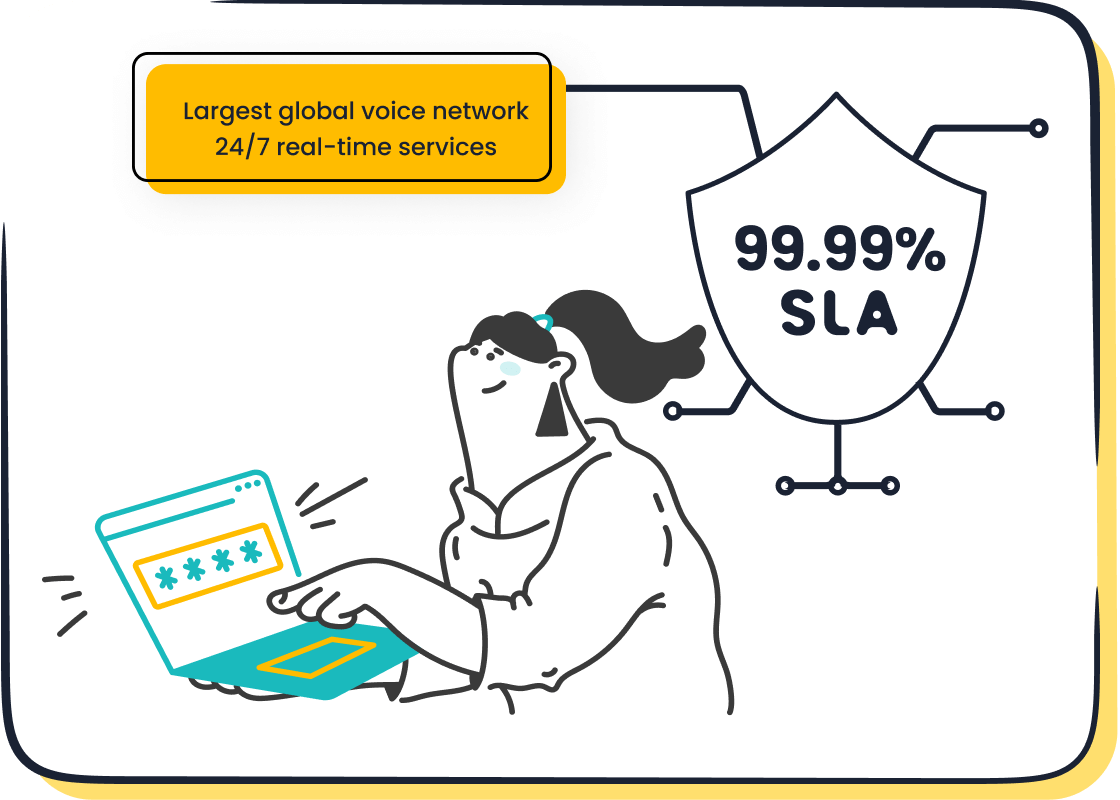Top Solutions for Voice Over Internet Protocol Issues

Voice over Internet Protocol (VoIP) has revolutionized how businesses communicate. It’s not just about making calls anymore. With VoIP, you can connect with customers from anywhere, access their preferences instantly, and even reduce wait times by routing calls to the right agents. Did you know the global VoIP market is projected to hit $236.25 billion by 2028? That’s massive growth, driven by businesses like yours embracing its flexibility and cost-effectiveness.
But let’s face it—common VoIP issues like dropped VoIP calls or jitter during VoIP calls can disrupt communication. That’s where Sobot steps in. With features like smart call routing and AI-powered voicebots, Sobot’s Voice/Call Center ensures seamless communication and helps you optimize network performance for crystal-clear VoIP call quality. Whether it’s solving call quality problems or preventing missed VoIP calls, Sobot offers effective VoIP solutions tailored to your needs.
Improving Poor Call Quality in VoIP
Understanding the Causes of Poor Call Quality
Insufficient Bandwidth and Network Congestion
Poor call quality often stems from insufficient bandwidth or network congestion. When your internet connection can't handle the data load, VoIP calls may sound choppy or distorted. Activities like streaming videos or large file downloads can hog bandwidth, leaving little room for smooth VoIP communication. Network congestion, especially during peak hours, can also lead to delays, packet loss, and jitter, all of which degrade call quality. A steady and reliable internet connection is essential for maintaining clear VoIP calls.
Outdated VoIP Hardware or Software
Using outdated VoIP hardware or software can also cause poor call quality. Older devices may lack the processing power to handle modern VoIP demands, while outdated software might not support the latest features or security protocols. For example, an old router might fail to prioritize VoIP traffic, leading to interruptions. Regular updates and equipment checks are crucial to ensure your system performs at its best.
Troubleshooting Tips for Better Call Quality
Optimize Internet Speed and Bandwidth Allocation
To improve call quality, start by optimizing your internet speed. Run a speed test to ensure your connection meets the minimum requirements for VoIP. Allocate bandwidth specifically for VoIP calls using router settings. This ensures other activities, like video streaming, don’t interfere with your communication.
Adjust Router's Quality of Service (QoS) Settings
Quality of Service (QoS) settings on your router can prioritize VoIP traffic over other types of data. By enabling QoS, you can reduce jitter, packet loss, and delays. This simple adjustment can significantly enhance call clarity, especially in busy networks.

Upgrade to Sobot's Voice/Call Center for Enhanced Performance
If you're still facing issues, consider upgrading to Sobot's Voice/Call Center. With features like smart call routing and a 99.99% uptime guarantee, Sobot ensures seamless communication. Its advanced monitoring tools help you track and resolve network issues quickly. Plus, the AI-powered Voicebot enhances call quality by reducing manual errors and improving response times. Businesses like Weee! have already seen a 20% boost in efficiency and a 50% reduction in resolution time using Sobot's solutions.
Pro Tip: Regularly monitor your network performance and conduct test calls to identify potential issues before they affect your VoIP calls.
Addressing Jitter and Latency in VoIP Systems
What Are Jitter and Latency?
Definitions and Their Impact on VoIP Communication
Jitter and latency are two common culprits behind poor VoIP performance. Jitter happens when there’s a variation in the delay of voice data packets arriving at their destination. This can lead to distorted audio, choppy speech, or even echoes during calls. Latency, on the other hand, refers to the time it takes for an audio signal to travel from one person to another. High latency causes noticeable delays, making conversations feel awkward and disjointed. Together, these issues can disrupt communication and frustrate both you and your customers.
Common Causes, Including Unstable Networks
Several factors contribute to jitter and latency. Network congestion is a major cause, especially during peak usage times. Outdated internet equipment, like old routers, can also struggle to handle VoIP traffic efficiently. Wireless connections often experience interference, leading to inconsistent packet delivery. Misconfigured Quality of Service (QoS) settings further worsen the problem by failing to prioritize voice data. Ensuring a stable and optimized network is key to minimizing these issues.
VoIP Troubleshooting to Reduce Jitter and Latency
Use Wired Connections for Stability
Switching from WiFi to a wired connection can significantly improve VoIP performance. Wired connections are more stable and less prone to interference, ensuring consistent packet delivery. If you’re using VoIP phones, connect them directly to your router or modem for the best results.
Implement Jitter Buffers and Optimize Network Settings
A jitter buffer can help smooth out packet arrival times, reducing audio distortions. Keep the buffer under 200 milliseconds to avoid adding unnecessary delays. Additionally, optimize your router’s settings by enabling QoS to prioritize VoIP traffic. This ensures voice packets get the bandwidth they need, even on busy networks.

Monitor Performance with Sobot's Call Tracking Tools
Sobot’s Voice/Call Center offers advanced call tracking tools to monitor your VoIP performance in real-time. These tools help you identify and resolve network issues before they impact call quality. With Sobot’s 99.99% uptime guarantee and smart call routing, you can maintain seamless communication and reduce jitter and latency effectively. Businesses like Weee! have already benefited from Sobot’s solutions, achieving faster resolution times and higher customer satisfaction.
Pro Tip: Regularly test your network and VoIP system to catch potential problems early. A proactive approach can save you from unexpected disruptions.
Preventing Dropped Calls in VoIP
Common VoIP Problems Leading to Dropped Calls
Weak Internet Connection and Signal Interference
Dropped calls often occur due to weak internet connections or signal interference. When your network struggles to handle voice traffic, calls may disconnect unexpectedly. Network congestion during peak hours can also cause interruptions. Similarly, signal interference from nearby devices, like microwaves or other wireless equipment, can weaken your connection. These issues highlight the importance of a stable and interference-free network for reliable VoIP performance.
Misconfigured VoIP Settings
Misconfigured VoIP settings are another common culprit behind dropped calls. Incorrect UDP timeout settings, for instance, can cause calls to terminate prematurely. Outdated firmware or software can also lead to compatibility issues between your VoIP hardware and network. Regularly reviewing and updating your VoIP configurations can help prevent these problems.
Steps to Ensure Reliable VoIP Connectivity
Ensure Stable Network and Router Placement
Start by optimizing your network. Place your router in a central location, away from walls or electronic devices that might interfere with the signal. Use wired connections for VoIP phones whenever possible, as they offer greater stability compared to WiFi. Prioritize VoIP traffic on your network using Quality of Service (QoS) settings to reduce congestion and improve call quality.
Regularly Update VoIP Software and Firmware
Outdated software and firmware can lead to dropped calls and other VoIP problems. Make it a habit to check for updates regularly. Updated systems often include bug fixes and compatibility improvements that enhance performance. Reliable equipment and up-to-date software ensure your VoIP system runs smoothly.

Leverage Sobot's Smart Call Routing for Seamless Communication
Sobot’s Voice/Call Center offers smart call routing, which ensures calls are directed to the right agents without delays. This feature minimizes the risk of dropped calls by optimizing call flow and reducing manual errors. With a 99.99% uptime guarantee and advanced monitoring tools, Sobot provides a stable and efficient solution for businesses. Companies like Weee! have already experienced improved connectivity and higher customer satisfaction using Sobot’s solutions.
Pro Tip: Test your VoIP system regularly to identify potential issues early. A proactive approach can save you from unexpected disruptions.
Fixing Echoing and Audio Distortions in VoIP
Causes of Echoing and Distorted Audio
Faulty Equipment and Poor Network Configuration
Echoing and distorted audio often result from faulty equipment or poor network setups. Damaged microphones, headsets, or VoIP phones can create hybrid or acoustic echoes. Improper circuit balancing in your VoIP system may also lead to feedback loops. On the network side, jitter and latency caused by slow internet or outdated routers can break up audio, making conversations frustrating. Electromagnetic interference from nearby devices like microwaves or wireless gadgets can worsen the problem.
Incorrect Microphone or Headset Settings
Sometimes, the issue lies in how your audio devices are configured. Using a speakerphone can cause your microphone to pick up the other person’s voice, creating an echo. Incorrect volume levels or sensitivity settings on your microphone or headset can also distort audio. These small missteps can disrupt communication, especially during important calls.
Troubleshooting Tips for Clear Audio
Replace or Adjust Audio Equipment
Start by inspecting your audio devices. Replace damaged microphones or headsets with high-quality ones designed for VoIP. If you’re using a speakerphone, switch to a headset to minimize echo. Ensure all cables are securely connected and free from wear and tear. Investing in reliable hardware can significantly improve call quality.
Calibrate VoIP Settings and Test Connections
Fine-tune your VoIP settings to optimize performance. Adjust microphone sensitivity and speaker volume to appropriate levels. Test your connection regularly to identify potential issues like jitter or packet loss. Implement Quality of Service (QoS) measures on your router to prioritize voice traffic. These steps can help you maintain clear and consistent audio.

Use Sobot's AI-Powered Voicebot for Enhanced Clarity
For a more advanced solution, consider Sobot's AI-powered Voicebot. It uses intelligent algorithms to reduce manual errors and improve audio clarity. With features like real-time monitoring and smart call routing, Sobot ensures seamless communication. Businesses like Weee! have already seen remarkable improvements, including a 96% customer satisfaction score, by adopting Sobot's solutions. You can achieve similar results by leveraging this cutting-edge technology.
Pro Tip: Regularly update your VoIP software and firmware to avoid compatibility issues and ensure optimal performance.
Enhancing VoIP Security to Prevent Vulnerabilities
Common Security Risks in VoIP Systems
Eavesdropping and Unauthorized Access
VoIP systems are vulnerable to eavesdropping, where hackers intercept and listen to private conversations without detection. This poses a significant risk, especially when sensitive information like customer details or financial data is discussed. Unauthorized access is another concern. Cybercriminals exploit weak passwords or unsecured networks to infiltrate systems, potentially leading to data breaches or service disruptions. These risks highlight the importance of securing your VoIP setup to protect both your business and your customers.
VoIP Phishing (Vishing) and Data Breaches
Vishing, a combination of voice calls and phishing, is a growing threat. Attackers impersonate legitimate entities to trick employees into revealing confidential information, such as passwords or account details. Additionally, malware targeting VoIP systems can sabotage operations and steal sensitive data. With remote work on the rise, mobile malware has become a significant risk, as it can access valuable information through smartphones. These threats emphasize the need for robust security measures to safeguard your VoIP system.
Best Practices for Securing VoIP Systems
Use Strong Passwords and Enable Encryption
Start by implementing strong passwords for all VoIP accounts and devices. Avoid using default credentials, as they are easy targets for hackers. Enable encryption to protect voice data during transmission. This ensures that even if someone intercepts the data, they cannot decipher it. Sobot's Voice/Call Center offers encrypted call transfer, providing an additional layer of security for your communications.
Regularly Update Firmware and Software
Outdated firmware and software can leave your VoIP system exposed to vulnerabilities. Regular updates often include security patches that address known issues. Make it a habit to check for updates and apply them promptly. This simple step can significantly reduce the risk of cyberattacks and ensure your system runs smoothly.

Protect Data with Sobot's Encrypted Call Transfer
Sobot's Voice/Call Center takes security a step further with encrypted call transfer. This feature ensures that all voice data is securely transmitted, protecting it from unauthorized access. By leveraging Sobot's advanced security measures, you can maintain business continuity, protect sensitive data, and comply with industry regulations. Businesses across various industries trust Sobot to provide secure and reliable VoIP solutions.
Pro Tip: Combine encryption with multi-factor authentication (MFA) for an added layer of protection against unauthorized access.
Preventative Measures and Best Practices for VoIP
Ensuring Network Stability and Performance
Conduct Regular Speed Tests and Optimize Bandwidth
You can’t have reliable VoIP without a stable network. Start by running regular speed tests to ensure your internet connection meets the demands of VoIP. If you notice slow speeds, consider optimizing bandwidth by prioritizing voice traffic. Quality of Service (QoS) settings on your router can help with this. They ensure voice data packets get priority, reducing delays and improving call clarity. Monitoring your network for issues like packet loss or latency also keeps your VoIP system running smoothly.
Use a Dedicated VoIP Network for Better Reliability
A dedicated VoIP network can make all the difference. It ensures your voice traffic doesn’t compete with other data-heavy activities like video streaming. This setup improves call quality and reduces the risk of dropped calls. Adding redundant power supplies and backup internet connections can also keep your VoIP system operational during outages. Choosing a reputable VoIP provider, like Sobot, guarantees better infrastructure and support, enhancing overall reliability.
Regular Maintenance and Updates
Schedule Routine Equipment Checks
Routine equipment checks are essential for avoiding unexpected VoIP issues. Inspect your hardware, such as routers and headsets, for wear and tear. Replace outdated devices to ensure compatibility with modern VoIP systems. Regularly testing your setup can help you catch potential problems early, saving you from costly disruptions.
Update Firmware and Software Consistently
Keeping your VoIP software and firmware up-to-date is non-negotiable. Updates often include security patches that protect your system from cyber threats. They also introduce new features and improve system stability. For example, Sobot’s Voice/Call Center regularly rolls out updates to enhance call routing and reduce technical issues. Make it a habit to check for updates and apply them promptly.
Training and Support for VoIP Users
Educate Teams on VoIP Troubleshooting Tips
Your team plays a crucial role in maintaining VoIP performance. Provide them with tailored training materials, like user guides and video tutorials. Hands-on sessions can help them gain practical experience with VoIP equipment. Teach them best practices, such as using quality headsets and testing connections before calls. Regular workshops or refresher courses ensure they stay updated on troubleshooting techniques.

Partner with Sobot for Comprehensive VoIP Solutions
Partnering with a trusted provider like Sobot simplifies training and support. Sobot offers ongoing assistance, including technical help and educational resources. Their Voice/Call Center equips your team with tools like smart call routing and real-time monitoring, making VoIP management easier. Businesses that work with Sobot often see improved efficiency and customer satisfaction, as demonstrated by companies like Weee!.
Pro Tip: Combining regular training with reliable VoIP solutions ensures your team is always prepared to handle challenges.
Addressing common VoIP problems is essential for maintaining seamless communication in your business. By tackling issues like poor call quality or dropped calls, you can ensure reliable communication, improve customer satisfaction, and boost productivity. Simple steps like prioritizing voice traffic with Quality of Service (QoS) measures and reducing network congestion can make a big difference.
Proactive maintenance plays a key role in keeping your VoIP system running smoothly. Regularly monitor data trends, update software, and implement strong security measures to prevent disruptions. Backing up system configurations and providing tailored training for your team also ensures long-term success.
Sobot's Voice/Call Center simplifies this process with advanced tools like real-time monitoring and encrypted call transfers. Businesses like Weee! have already seen remarkable improvements in efficiency and customer satisfaction. Take the next step to enhance your communication and explore how Sobot can transform your customer service experience.
Pro Tip: A well-maintained VoIP system not only improves call quality but also strengthens your business's reputation for reliability.
FAQ
What is VoIP, and how does it work?
VoIP stands for Voice over Internet Protocol. It lets you make calls using the internet instead of traditional phone lines. It converts your voice into digital signals and sends them over the web. This technology is cost-effective and works well for businesses of all sizes.
How can I improve VoIP call quality?
Start by optimizing your internet connection. Use wired networks instead of WiFi for stability. Adjust your router’s Quality of Service (QoS) settings to prioritize voice traffic. Tools like Sobot’s Voice/Call Center can also help monitor and enhance call performance.
Why do VoIP calls sometimes drop?
Dropped calls usually happen due to weak internet connections or misconfigured VoIP settings. Place your router centrally and update your firmware regularly. Sobot’s smart call routing minimizes disruptions by ensuring calls reach the right agents efficiently.
Is VoIP secure for business communication?
Yes, but it depends on your setup. Use strong passwords and enable encryption to protect your data. Sobot’s Voice/Call Center offers encrypted call transfers, ensuring your conversations stay private and secure.
Can VoIP handle high call volumes?
Absolutely! VoIP systems scale easily to handle large call volumes. Sobot’s Voice/Call Center supports global telephony contacts and offers features like bulk outbound tasks, making it ideal for businesses managing high traffic.
See Also
Best VoIP Solutions for Small Enterprises in 2024
Leading VoIP Applications to Consider This Year
Best Reviewed Automated Calling Software for 2024
Comparing Free and Paid Voice Over Software Choices
Setting Up Interactive Voice Response IVR Software Effectively